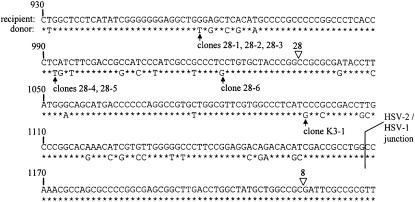Figure 3.—
Nucleotide sequences of gene conversion tracts containing homeologous HSV-2 tk sequence. Nucleotide numbering is according to Wagner et al. (1981). The upper line of sequence is HSV-1 tk sequence from a portion of the recipient tk genes in pHYB21A and pHYB21A-28. The locations of the XhoI linker insertion in tk mutant 8 (the recipient gene in pHYB21A) and in tk mutant 28 (the recipient gene in pHYB21A-28) are indicated by labeled inverted triangles. The lower line of sequence is from a portion of the common hybrid donor tk sequence in both pHYB21A and pHYB21A-28, with the junction between HSV-2 and HSV-1 sequence shown. An asterisk is present at each position in the donor sequence where the donor is identical to the recipient HSV-1 tk sequence. In the HSV-2 tk portion of the donor, each nucleotide difference between donor HSV-2 tk and recipient HSV-1 tk sequence is indicated. Beneath the donor sequence is indicated the upstream-most HSV-2 tk marker in the gene conversion tracts of recovered clones. Clone K3-1 was recovered from cell line K3 containing pHYB21A. The gene conversion tract from clone K3-1 contains the HSV-2 “G” nucleotide indicated by the arrow as well as every downstream HSV-2 nucleotide marker through the position of the HSV-2/ HSV-1 junction. Clones 28-1–28-6 were recovered from lines containing HYB21A-28. The gene conversion tract from each clone contains the HSV-2 nucleotide indicated by the appropriate arrow as well as every downstream HSV-2 nucleotide marker through the position of the HSV-2/HSV-1 junction. Every gene conversion tract appeared to be continuous except for the tract from clone 28-5. Clone 28-5 displays a “C” (equal to HSV-1 sequence) at position 995 despite displaying 2 upstream and 25 downstream HSV-2 markers.

